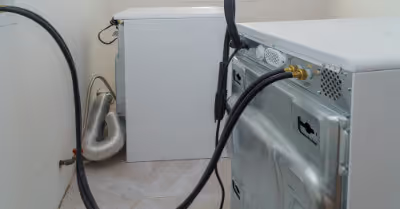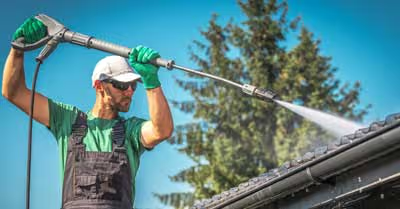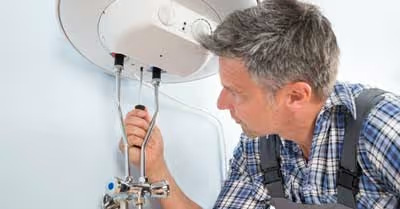Table of Contents
What are Drain Flies?
Drain flies are pesky insects that mostly congregate around stagnant water. Measuring 2 to 5 millimeters, drain flies are sometimes known as filter flies, sewer flies, or moth flies. They're commonly gray or taupe in color and have small rounded wings. This means that they don't have the perfect features to fly far and cannot fly for more than 3 meters. As such, they just hop and jump from surface to surface.
These pesky insects generally live for three weeks while they can hatch new eggs every 48 hours, so it can be a real problem if they start breeding inside your house. Their body and wings are covered in small hair to give them fuzzy appearances while the wings are larger than their bodies. Additionally, they're nocturnal and you'll often spot them resting on walls and ceilings or near infested areas.
What Causes Drain Flies?
As the name suggests, drain flies in drains where they can access stagnant or shallow waters. This is why you'll mostly find them near sources of food and bacteria such as sinks, drains, and showers. These annoying insects prefer areas that have been left untouched for quite some time or areas that are not used frequently.
They thrive on organic moisture and debris and will even pop in very clean areas. However, you spot them in rarely-used areas such as workshops or basement sinks. As such, you shouldn't be surprised to find them inside your home if you've spent time away from home, say when on vacation.
Are Drain Flies Harmful?
Given that they do not bite, drain flies are not harmful to humans. They also do not transmit any disease to humans. However, they can contaminate your foodstuff, given that they often come into contact with filthy places and this is something that you don't want. They can also multiply very fast and can be a complete nuisance within a few days.
How to Spot Drain Flies
One of the simplest ways to spot drain flies is by spotting them perching or resting on walls, ceilings, and near infested areas. In other words, you can spot them with naked eyes. The fact that they aren't good at flying means that they won't venture far. You'll, therefore, find them resting not far from their food source or the infested area.
In most cases, they use sewers and drain pipes as their breeding grounds. If they've multiplied, you can carry out a test to determine whether you have a serious problem. All you have to do is cover all the outlet drains and pipes with sticky tape. The drain flies will get stuck on the sticky tape if they try to come out and this is an indication that you have an infestation.
Here's what to do.
Thoroughly clean and dry the areas in your kitchen and bathroom.
- And because drain flies are more active in the evening and at night, seal all the drain outlets using clear sticky tape. The tape should face downwards.
- Leave the sticky tape overnight and check in the morning if there are any flies stuck on the tape. If there are drain flies stuck on the tape, this is an indication that you have an infestation. On the contrary, you can repeat the test for at least 4 nights if you don't find any drain flies stuck on the tape.
- You can also take a clear container and line the inside with petroleum jelly. Put the container facing downwards on the drain outlets. If the drain has a large number of drain flies, they'll get trapped by the jelly inside the container and this will confirm their presence.
Getting Rid of Drain Flies
The first thing you should do if you want to get rid of drain flies is to locate their source. You can check both outside and inside in areas such as the damp areas beneath air conditioning units, damaged sewer lines, or any place that has a pool of still water. You can also look near the sink, in the bathroom drains, toilets, floor drains, and showers.
Here is how to get rid of drain flies.
Eliminate their Food Source
As with any pest control, the first and most important thing is to eliminate what attracts them to your home in the first place. In this case, you should make sure that any area that may have even the slightest still water is thoroughly cleaned and dried out.
Keep in mind that drain flies are attracted to damp areas in your home. As such, you can consider pouring a commercial drain cleaner down the drains to break down and eliminate the organic materials that drain flies usually feed on. You can also use a plumbing grade bristled brush to scrub away the drains and remove the organic materials.
Once you've removed their food source, they'll just leave on their own and the remaining ones will die out. And without the organic matter to lay their eggs, it will take a few weeks and this pest problem will be a thing of the past.
Clean the Infested Areas
To be honest, you will, in some cases, find drain flies even the cleanest of homes. What does this mean? Well, it means that their food source and breeding grounds have not been eliminated. That being said, you should thoroughly clean their breeding grounds. While you might feel the urge of pouring a bottle of chemical down the drains, this will not effectively remove the organic materials.
Instead, make sure that the infested areas are thoroughly cleaned. You can start by running hot water down the drains. You can then use the plumbing-grade bristled brush to scrub the drains and remove the organic materials that have built inside the drains.
Use a mixture of White Vinegar, Dish Soap, and Hot Water
Dumping a pot of hot water down the drains can be an effective way of eliminating the drain flies. But to keep the drain flies away, you can add a little white vinegar and dish soap to the hot water and pour it down the drain at least twice a day for a week or until you no longer see the drain flies.
Trap the Drain Flies
You can also choose to eliminate the drain flies by trapping. You can fill up a jar with equal portions of water, sugar, and white vinegar and add about 10 drops of soap dish to the mixture. Leave the mixture next to the infested areas overnight for about a week or until the drain flies are all gone.
You can also trap the drain flies by covering the inside of a container with petroleum jelly and placing it downwards on the drain outlets. The sticky tape method that's commonly used in testing whether the drain flies are in the drains can be an effective way of eliminating these pesky insects.
How to Keep Drain Flies from Returning
The tips below can help you in ensuring that the drain flies do not return.
- Make sure that the drains are cleaned periodically and are clog-free.
- Remove all the stagnant water in all areas of your home.
- You can occasionally spray an Insect Growth Regulator in your drains. This is to prevent the drain flies from developing from eggs to become adult drain flies. This is a perfect way of preventing future infestation.
- More importantly, make sure that every part of your home is clean at all times and is devoid of still water.
Bottom Line
There you have it; you should never let drain flies cause you more headaches. Although they're not harmful to humans, having them fly around in your house can be very annoying. All you have to do is to make sure that the drains are clean and free of organic matter. You can do this by occasionally cleaning the drains and pouring hot water down the drains. You should also make sure that there are no damp areas of still water inside your house. Hopefully, this will help you eradicate these annoying insects.
Recent Articles
















